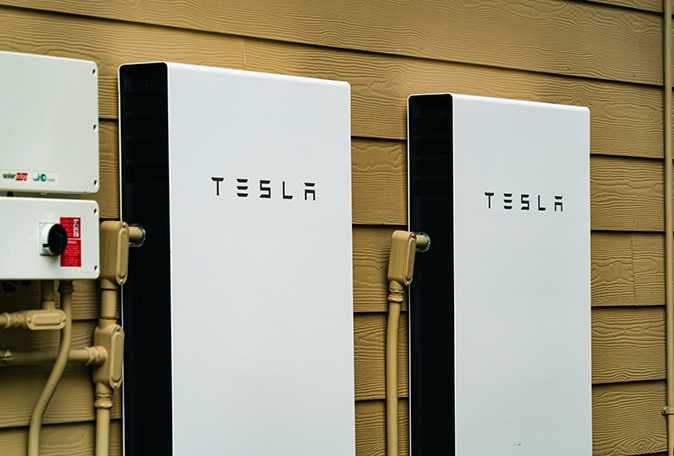Backup battery systems store renewable energy, providing uninterrupted power during outages, enhancing self-sufficiency, and reducing grid reliance.
Investing in a battery backup for your renewable energy system offers you several considerable advantages. For instance, it provides energy independence, allowing you to rely on stored power during peak usage times, reducing your electricity costs and decreasing the load on the power grid. In the event of a blackout, you have a reliable power source, increasing your home’s resilience. Also, with battery storage, you make the most of your renewable energy production, using the solar, wind, or hydro power you generate even when conditions are not optimal. This not only helps you minimize your carbon footprint but also bolsters the broader efforts towards decarbonization and climate change mitigation. Battery backup systems are a smart, sustainable, and forward-thinking choice, effectively turning your home into a micro power station.
Typical Components (for solar)
1Solar Panels
Capture sunlight and convert it into DC electricity.
2Inverter
DC electricity from solar panels or batteries into AC for home use.
3Charge Controller
DC electricity from solar panels or batteries into AC for home use.
4Battery Bank
Stores excess solar power for use when solar panels aren’t generating electricity, like during night or cloudy days.
5Battery Management System (BMS)
Monitors and controls charging/discharging to protect and optimize battery performance.
6Meter and Disconnects
Provide safety and isolation, while monitoring power output and usage.
7Backup Generator
Optional but adds redundancy, used in prolonged poor weather.
Pros
- Energy Independence and Reliability: Battery backup provides consistent power even during grid outages or non-generation periods. This is a significant advantage over relying on a grid-tied solar system or a fossil-fueled generator.
- Lower Electricity Costs: By storing excess energy for use during peak hours, battery backup systems can lead to significant savings, especially in places with time-of-use pricing or low feed-in tariffs.
- Carbon Footprint Reduction: By harnessing renewable sources and reducing reliance on fossil fuels, battery backups help mitigate climate change, a benefit not offered by traditional power sources.
Cons
- Initial Cost: The upfront cost of battery backup systems can be high, often requiring a larger investment than a simple grid-tied solar setup.
- Battery Lifespan: While improving, batteries degrade over time and may require replacement every 5-15 years, depending on type and usage.
- Maintenance: Regular monitoring and occasional maintenance are required to ensure optimal system performance and longevity, a demand not present in direct grid supply.
Costs
1New Construction
For new constructions, incorporating a battery backup system from the beginning often has the lowest overall cost. The premium for adding a battery backup system largely depends on the size and type of the battery and the complexity of the system, but could range between $5,000 and $15,000 over the cost of a standard solar PV system. This includes the cost of the battery itself, plus the additional costs of wiring, installation, and a more advanced inverter.

2Existing Home (Hiring a Contractor)
If you’re adding a battery backup to an existing solar PV system, you might spend between $8,000 and $20,000. This estimate includes the cost of the battery, installation labor, and potentially upgrading the inverter and other system components.
3Existing Home (DIY)
For DIY enthusiasts, you might be able to install a battery backup system for between $4,000 and $12,000. This estimate includes the cost of the battery and other necessary components, but not the cost of labor. However, keep in mind that solar and electrical systems can be complex and working with them can be dangerous, so this option is generally only recommended for those with significant experience or technical knowledge.

Hiring Pros
- Use Verified Websites: Start your search with trusted websites such as those found in our resources.
- Ask for References and Check Reviews: Request references from previous clients. Online reviews can also provide insights into the installer’s professionalism and the quality of their work.
- Verify Credentials: Ensure your chosen installer is certified, licensed, and insured. Valid credentials indicate adherence to industry standards and safety regulations.
- Request a Comprehensive : Ask for an all-inclusive quote that covers system design, equipment, installation, permits, and warranty details to avoid hidden costs.
- Discuss Maintenance and Support: Post-installation support is crucial. Ensure the installer provides a clear explanation of required maintenance and warranty procedures, and their availability for future assistance.

Do It Yourself
- Seek Knowledge: Start your search with trusted books & websites such as those found in our resources.
- Understand Local Regulations: Check with your local jurisdiction about permits and regulations for home solar energy systems. Some areas may require professional installation.
- Safety First: Installing a battery backup system involves electrical work. Understand safety protocols, and never hesitate to hire a professional if unsure.
- Choose Quality Equipment: Purchase equipment from reputable manufacturers. Cheap or counterfeit products may compromise system performance and safety.
- Plan for Maintenance: Understand the maintenance requirements of your system. Regular check-ups can ensure optimal performance and increase the lifespan of your system.
Tips for Renters
Looking for a Rental:
1Check Rental Listings
Websites like Apartments.com, RentCafe.com, and Zillow have filters for energy-efficient and green homes. Use these to narrow your search.
2Ask Directly
When you contact landlords or real estate agents, ask specifically if the property has a battery backup for a renewable energy system.
3Visit Green Rental Communities
These communities prioritize sustainability and may be more likely to have advanced features like battery backup.

Convincing a Landlord:
1Highlight Cost and Energy Savings
Demonstrate how a battery backup can reduce energy bills and improve energy independence.
2Present Financial Incentives
Show them resources like DSIRE (dsireusa.org), highlighting rebates, tax credits, and other incentives that offset installation costs.
3Discuss Increased Property Value
Emphasize how green upgrades can attract conscientious tenants and increase property value in the long run.
Tips for Designers & Builders

For the Design Team:
1Consider System Sizing and Location
Assess the building’s energy needs to correctly size the battery backup system. Also, select an appropriate, safe location for the battery installation, considering temperature control, accessibility, and safety measures.
2Plan for Future Expansion
Design the system to be scalable, allowing for potential future expansion of the solar PV array or addition of more batteries as energy needs increase.
3Ensure Compliance
Stay updated with local regulations, grid interconnection standards, and fire safety norms to ensure the design aligns with all necessary legal requirements.

For the Builder:
1Ensure Qualified Installation
The installation should be conducted by trained, certified professionals to ensure safety and efficiency. Incorrect installation could result in system failure or safety hazards.
2Prioritize Quality Materials
Utilize high-quality, durable materials and products from reputable manufacturers. This can improve the system’s longevity, performance, and safety.
3Create a Maintenance Plan
Plan for regular system maintenance and inspections to keep the system functioning at peak efficiency. Provide the owner with a detailed maintenance schedule and any necessary training to understand and monitor the system.
1Consider System Sizing and Location
Assess the building’s energy needs to correctly size the battery backup system. Also, select an appropriate, safe location for the battery installation, considering temperature control, accessibility, and safety measures.
1Ensure Qualified Installation
The installation should be conducted by trained, certified professionals to ensure safety and efficiency. Incorrect installation could result in system failure or safety hazards.
2Plan for Future Expansion
Design the system to be scalable, allowing for potential future expansion of the solar PV array or addition of more batteries as energy needs increase.
2Prioritize Quality Materials
Utilize high-quality, durable materials and products from reputable manufacturers. This can improve the system’s longevity, performance, and safety.
3Ensure Compliance
Stay updated with local regulations, grid interconnection standards, and fire safety norms to ensure the design aligns with all necessary legal requirements.
3Create a Maintenance Plan
Plan for regular system maintenance and inspections to keep the system functioning at peak efficiency. Provide the owner with a detailed maintenance schedule and any necessary training to understand and monitor the system.
Resources
Books:
“OFF-GRID SOLAR POWER: Reset the Cost of Bills With This Practical Guide to Design,Assemble,and Install Your DIY Electrical System for Tiny Houses,Shipping Container Homes,Boats,RVs,and Cabins” by Robert Price.
“Solar Power for Beginners: How to Design and Install the Best Solar Power System for Your Home (DIY Solar Power)” by Paul Holmes.
Websites:
Database of State Incentives for Renewables & Efficiency (DSIRE): (https://www.dsireusa.org).
- Energy Sage: (https://www.energysage.com).
- U.S. Department of Energy – Energy Storage page: (https://www.energy.gov/oe/energy-storage-rdd).





